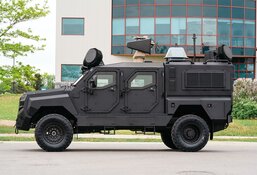DroneShield Ltd.'s (DRO:ASX; DRSHF:OTC) Q2/25 financial results show that "revenue acceleration is now translating into free cash flow generation," reported Abraham Akra, senior analyst at Shaw and Partners, in a July 30 research note. As such, Shaw and Partners upgraded its recommendation to Buy from Hold and raised its target price by 80%.
"We see the business pivoting from capex and inventory buildout to cash generative, with operating scale and a capital light balance sheet underpinning an expansion phase that is derisked by full-year 2025 revenue visibility at AU$176 million (AU$176M)," Akra wrote.
14% Uplift Suggested
Shaw and Partners' new target price on DroneShield is AU$3.60, up from AU$2 per share previously, noted Akra. Compared to AU$3.60, the company was trading at AU$3.16 per share at the time of the analyst's report.
The difference between these prices implies a potential return for investors of 14%. The company's market cap is AU$2.8 billion (AU$2.8B).
Akra reported that DroneShield's major shareholders are Fidelity Management & Research Co. LLC with 8.1%, The Vanguard Group Inc. with 5.5%, Regal Funds Management Pty. Ltd. with 5.4%, State Street Global Advisors Australia with 4.1% and Epirus Inc. with 2.1%.
Free Cash Now Flowing
Growth and expansion is the theme of Akra's update on DroneShield, a counterdrone solutions developer and manufacturer. The analyst highlighted a significant shift for the company: free cash flow began in Q2/25. Net operating cash was AU$13.4M, boosting liquidity at quarter's end to about AU$204M with zero debt.
"With about AU$204M cash and strong gross margins, the company can fund growth organically while retaining mergers and acquisitions optionality," Akra wrote.
DroneShield achieved this despite greater need for working capital, the analyst pointed out. The company's baseline fixed cash opex rose in Q2/25 to about AU$8.5M per month, up from AU$6.5M in Q1/25. DroneShield bolstering its staff and facilities have caused costs to rise, but interest income and operating leverage offset some of them.
DroneShield now has 363 employees. Of this total, 285 are engineers, to support the company's growing product portfolio and quarterly artificial intelligence-powered software releases. An increase in software-as-a-service (SaaS) sales is expected as a result. DroneShield just introduced SentryCiv, a civilian, detect-only subscription targeted to airports and utilities, which expands its total addressable market beyond government defense.
The company also is expanding its manufacturing capacity to AU$2.4B from AU$500M, in part with a new 3,000-square-meter Sydney line and partnerships in the European Union and the U.S.
Also in Q2/25, DroneShield's net profit exceeded Shaw and Partners' expectation, noted Akra. Revenue increased 3–4%. These achievements led the financial firm to raise its estimates for EBITDA and net profits after tax by 15% and 33% for 2025, 20% and 57% for 2026 and 13% and 28% for 2027, respectively.
Growing Pipeline, Inventory
Akra also noted that DroneShield's visible sales pipeline consists of 284 live opportunities and totals $2.33B. Thirteen of the deals are for more than AU$30M, and 52 exceed AU$5M. The largest of these opportunities is from Europe, no longer the U.S., a result of the NATO rearmament and DroneShield's plans to establish a regional manufacturing hub on the continent.
The company boasts an inventory of $81M (book), equating to AU$270M in sales. This on-hand stock protects DroneShield's lead times and allows the company to quickly fill large orders, the analyst wrote.
Pivotal Events for Investors
Three high-profile events changed what investors expect from drone and counterdrone suppliers, wrote Akra. One was Ukraine's Operation Spiderweb, a covert attack deep inside Russia in which swarms of long-range drones struck five air bases and reportedly destroyed dozens of bombers. The operation proved that inexpensive drones can penetrate deep, strategic targets.
Israel's Operation Rising Lion was the second pivotal event. Drones smuggled into Iran silently blinded more than 70 radar and missile batteries, thereby carving out a pathway for Israeli Air Force jets. This operation showed how offensive drones can neutralize high-end air defense grids.
The third event was the U.S. Congress extending the Department of Homeland Security and Department of Justice's counterdrone powers through fiscal year 2028. Relatedly, at the time of Akra's report, Congress was considering bills allowing airports, stadiums and utilities company to deploy drone mitigation technology. In July hearings, the U.S. House of Representatives warned that hostile drone swarms could overwhelm unprotected sites.
"Together with the U.S. funding to drones/counterdrones in the Big Beautiful Bill and Europe's wider 'rearm' spend, these events crystalize a global shift from experimental trials to urgent procurement," Akra wrote.
What to Watch For
According to DroneShield, it sees three notable near-term potential catalysts. Recently it was awarded AU$5M in contracts from the LAND 156 Australian Army program, and progress fulfilling these could catalyze its share price. Conversion of the company's $2.3B pipeline into incremental 2025-2026 purchase orders could boost DRO. Another possible catalyst is the expected surge in SaaS business when the company introduces next-generation products in 2026r.
"Index reweighting (ASX100 inclusion plausible) and potential U.S. defense authorizations could provide additional tailwinds," Akra wrote.
| Want to be the first to know about interesting Technology investment ideas? Sign up to receive the FREE Streetwise Reports' newsletter. | Subscribe |








































